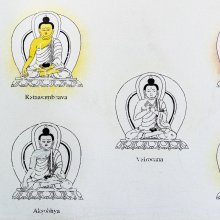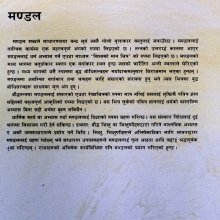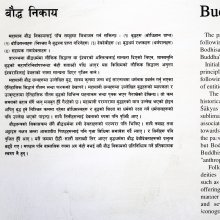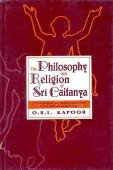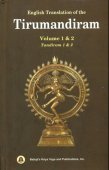Svarupa, Svarūpa, Sva-rupa: 31 definitions
Introduction:
Svarupa means something in Hinduism, Sanskrit, Jainism, Prakrit, the history of ancient India, Marathi, Hindi, biology. If you want to know the exact meaning, history, etymology or English translation of this term then check out the descriptions on this page. Add your comment or reference to a book if you want to contribute to this summary article.
Alternative spellings of this word include Swarup.
Images (photo gallery)
(+1 more images available)
In Hinduism
Samkhya (school of philosophy)
Source: Wisdom Library: Sāṃkhya philosophySvarūpa (स्वरूप, “homogeneous”) refers to one of the two types of pariṇāma (change) according to the Sāṃkhya theory of evolution. It is also known as sadṛśa. Svarūpa-pariṇāma occurs during pralaya (dissolution), when each guṇa goes on transforming in itself without establishing dominance over the other guṇas. Pariṇāma refers to the ‘change’ or ‘flux’ occurring in prakṛti (matter), but which is absent in puruṣa (consciousness).
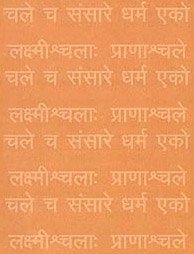
Samkhya (सांख्य, Sāṃkhya) is a dualistic school of Hindu philosophy (astika) and is closeley related to the Yoga school. Samkhya philosophy accepts three pramanas (‘proofs’) only as valid means of gaining knowledge. Another important concept is their theory of evolution, revolving around prakriti (matter) and purusha (consciousness).
Natyashastra (theatrics and dramaturgy)
Source: Wisdom Library: Nāṭya-śāstraSvarūpa (स्वरूप) refers to one of the twenty prakāras: rules used in the playing of drums (puṣkara) [with reference to Mṛdaṅga, Paṇava and Dardura] according to the Nāṭyaśāstra chapter 33. Accordingly, “when the playing has a simple nature and is done by sama-pāṇi, and follows its own fixed pattern, it is called Svarūpa”.

Natyashastra (नाट्यशास्त्र, nāṭyaśāstra) refers to both the ancient Indian tradition (shastra) of performing arts, (natya—theatrics, drama, dance, music), as well as the name of a Sanskrit work dealing with these subjects. It also teaches the rules for composing Dramatic plays (nataka), construction and performance of Theater, and Poetic works (kavya).
Purana and Itihasa (epic history)
Source: archive.org: Puranic EncyclopediaSvarūpa (स्वरूप).—An asura. This asura remains in the palace of Varuṇa and serves him. (Sabhā Parva, Chapter 9, Verse 14).
Source: archive.org: Shiva Purana - English TranslationSvarūpa (स्वरूप) refers to “one’s own real form”, according to the Śivapurāṇa 2.3.10.—Accordingly, as Brahmā narrated to Nārada:—“[...] Returning to His mountain, Śiva in his excitement caused by his separation from his beloved, remembered Satī, who was dearer to Him than his very life. [...] Abandoning the polished manners of a householder, He cast off his dress and roamed about all the worlds, clever in divine sports that He was. Not seeing her anywhere, the pangs of his separation from Satī increasing, Śiva, the benefactor of His devotees, returned to His mountain and entered into trance for the destruction of misery. Thereupon He saw His imperishable real form [i.e., svarūpa]. [...]”.

The Purana (पुराण, purāṇas) refers to Sanskrit literature preserving ancient India’s vast cultural history, including historical legends, religious ceremonies, various arts and sciences. The eighteen mahapuranas total over 400,000 shlokas (metrical couplets) and date to at least several centuries BCE.
Vaishnavism (Vaishava dharma)
Source: Pure Bhakti: Bhagavad-gita (4th edition)Svarūpa (स्वरूप) refers to “the eternal nature and iden-tity of the self; one’s transcendental form”. (cf. Glossary page from Śrīmad-Bhagavad-Gītā).
Source: Pure Bhakti: Bhajana-rahasya - 2nd EditionSvarūpa (स्वरूप) refers to:—Constitutional nature, inherent identity; the eternal constitutional nature and identity of the self which is realised at the stage of bhāva. (cf. Glossary page from Bhajana-Rahasya).
Source: Pure Bhakti: Brhad BhagavatamrtamSvarūpa (स्वरूप) refers to:—Intrinsic form and nature; true nature; natural position. (cf. Glossary page from Śrī Bṛhad-bhāgavatāmṛta).

Vaishnava (वैष्णव, vaiṣṇava) or vaishnavism (vaiṣṇavism) represents a tradition of Hinduism worshipping Vishnu as the supreme Lord. Similar to the Shaktism and Shaivism traditions, Vaishnavism also developed as an individual movement, famous for its exposition of the dashavatara (‘ten avatars of Vishnu’).
Shaktism (Shakta philosophy)
Source: Google Books: ManthanabhairavatantramSvarūpa (स्वरूप) refers to one’s “essential nature”, according to the second recension of the Yogakhaṇḍa of the Manthānabhairavatantra, a vast sprawling work that belongs to a corpus of Tantric texts concerned with the worship of the goddess Kubjikā.—Accordingly, as Śrīkaṇṭha said to the Goddess: “Having abandoned this Vaiṣṇavī Māyā, reveal (your) essential nature (svarūpa). Tell me the Kula liturgy (krama) and (give me) the Kaulika consecration. O mistress of the gods, you are my saviour. There is no other (true) Vidyā at all. (I am) devoid of the Command and have fallen from (my) austerities. O mistress of the gods, tell (me) the knowledge (that will liberate me)”.

Shakta (शाक्त, śākta) or Shaktism (śāktism) represents a tradition of Hinduism where the Goddess (Devi) is revered and worshipped. Shakta literature includes a range of scriptures, including various Agamas and Tantras, although its roots may be traced back to the Vedas.
Shaivism (Shaiva philosophy)
Source: Brill: Śaivism and the Tantric Traditions1) Svarūpa (स्वरूप) refers to “one’s (true) nature”, according to the Īśvarapratyabhijñāvivṛtivimarśinī (KSTS vol. 65, 327–331).—Accordingly, “[Utpala teaches that] the ‘distinguishing mark of samāveśa’ is ‘insight,’ since it is opposed to the Impurity that is ignorance, being characterized by a perfect, that is to say complete (‘ā samantāt’), entry into one’s true nature (satya-svarūpa), obtaining which one becomes a gnostic, and practicing which, on the levels of body, prāṇa, etc., one becomes a Yogī, due to attaining the glory that is an intrinsic quality of infinite Consciousness.”.
2) Svarūpa (स्वरूप) refers to “one’s own form”, according to the Mālinīvijayottaratantra, chapter 18 (“appropriate conduct of the accomplished Yogin”) verses 18.74-81 (as quoted in the Tantrāloka verse 4.213-221ab).—Accordingly, “[...] And as regards the performance or non-performance of vows, etc., and entrance into sacred places, etc. [i.e., kṣetras, pīṭhas, and upapīṭhas], the observance of rules of action, and (those rules associated with) initiatory name, initiatory lineage, or the like [i.e., according to the lodge and the like of the initiate], whether the form, sectarian marks, and so on be one’s own or another’s [i.e., svarūpa—parasvarūpaliṅgādi]—nothing is prescribed here regarding these, nor, contrariwise, prohibited. [...]”.
Source: SOAS University of London: Protective Rites in the Netra TantraSvarūpa (स्वरूप) refers to the “characteristics (of mantras)”, according to the Netratantra of Kṣemarāja: a Śaiva text from the 9th century in which Śiva (Bhairava) teaches Pārvatī topics such as metaphysics, cosmology, and soteriology.—Accordingly, [verse 21.1]—“O Deva, what are mantras composed of? What are their characteristics (svarūpa—mantrāḥ ... kiṃsvarūpāś)? What do they look like? What power [do they] possess? What makes them powerful? How are they able [to be effective] and who impels them [to be productive]?”.

Shaiva (शैव, śaiva) or Shaivism (śaivism) represents a tradition of Hinduism worshiping Shiva as the supreme being. Closely related to Shaktism, Shaiva literature includes a range of scriptures, including Tantras, while the root of this tradition may be traced back to the ancient Vedas.
Kavyashastra (science of poetry)
Source: DASH: The Theology of Literary Emotions in Medieval KashmirSvarūpa (स्वरूप) refers to the “true nature” (of poetic manifestation), according to the Ānandavardhana’s 9th century Dhvanyāloka, an important philosophical work on the theory of poetic manifestation (dhvani) or ‘the soul of poetry’.—Accordingly, “In view of such disagreements [over the existence and nature of poetic manifestation], we shall state its true nature (svarūpa) in order to delight the hearts of sensitive readers. For the nature of this [poetic manifestation], which is the secret of all good poets' poetry, which, moreover, is clearly seen to be at work in such great poems as the Rāmāyaṇa and the Mahābhārata, will here be revealed so that the bliss [which arises] in the hearts of sensitive readers. . . may take firm hold in their hearts”.

Kavyashastra (काव्यशास्त्र, kāvyaśāstra) refers to the ancient Indian tradition of poetry (kavya). Canonical literature (shastra) of the includes encyclopedic manuals dealing with prosody, rhetoric and various other guidelines serving to teach the poet how to compose literature.
Yoga (school of philosophy)
Source: ORA: Amanaska (king of all yogas): A Critical Edition and Annotated Translation by Jason BirchSvarūpa (स्वरूप) refers to the “essential nature (of supreme bliss)”, according to the Vijñānabhairavatantra (74).—Accordingly, “Wherever there is satisfaction of mind, one should hold the mind right there, [because] wherever [the mind is,] its essential nature of supreme bliss (parānanda-svarūpa) is present”.

Yoga is originally considered a branch of Hindu philosophy (astika), but both ancient and modern Yoga combine the physical, mental and spiritual. Yoga teaches various physical techniques also known as āsanas (postures), used for various purposes (eg., meditation, contemplation, relaxation).
General definition (in Hinduism)
Source: JQ's Likhita Japa Journal: HinduismSvarūpa in Sanskrit this means “lover of beauty”. This is one of the 108 names of Lord Ganesha.
Source: Ashtanga Yoga: Yoga Sutrani Patanjalisvarūpa = own form; true nature; true form
In Jainism
General definition (in Jainism)
Source: Wisdom Library: JainismSvarūpa (स्वरूप) refers to a class of bhūta deities according to the Digambara tradition of Jainism, while Śvetāmbara does not recognize this class. The bhūtas refer to a category of vyantaras gods which represents one of the four classes of celestial beings (devas).
The deities such as the Svarūpas are defined in ancient Jain cosmological texts such as the Saṃgrahaṇīratna in the Śvetāmbara tradition or the Tiloyapaṇṇati by Yativṛṣabha (5th century) in the Digambara tradition.
Source: archive.org: TrisastisalakapurusacaritraSvarūpa (स्वरूप) and Pratirūpa are the two Indras (i.e., lords or kings) of the Bhūtas who came to the peak of Meru for partaking in the birth-ceremonies of Ṛṣabha, according to chapter 1.2 [ādīśvara-caritra] of Hemacandra’s 11th century Triṣaṣṭiśalākāpuruṣacaritra: an ancient Sanskrit epic poem narrating the history and legends of sixty-three illustrious persons in Jainism.
Source: Encyclopedia of Jainism: Tattvartha Sutra 4: The celestial beings (deva)Svarupa (स्वरुप) refers to one of the two Indras (lords) of the Bhūta class of “peripatetic celestial beings” (vyantara), itself a main division of devas (celestial beings) according to the 2nd-century Tattvārthasūtra 4.6. Pratirupa and Svarupa are the two lords in the class ‘devil’ peripatetic celestial beings.
Source: The University of Sydney: A study of the Twelve ReflectionsSvarūpa (स्वरूप) refers to the “true nature”, according to the 11th century Jñānārṇava, a treatise on Jain Yoga in roughly 2200 Sanskrit verses composed by Śubhacandra.—Accordingly, “This [self], which is master of the three worlds, omniscient [and] possessed of infinite power, does not recognise itself and has deviated from its own true nature (sva-svarūpa). Tarnished by awful stains arising from eternity, it grasps objects according to its own desire which are very different from itself”.

Jainism is an Indian religion of Dharma whose doctrine revolves around harmlessness (ahimsa) towards every living being. The two major branches (Digambara and Svetambara) of Jainism stimulate self-control (or, shramana, ‘self-reliance’) and spiritual development through a path of peace for the soul to progess to the ultimate goal.
India history and geography
Source: Cologne Digital Sanskrit Dictionaries: Indian Epigraphical GlossarySvarūpa.—(SITI), an estate of the Nambūdris, royal per- sonages, etc., of Malai-nāḍu. Note: svarūpa is defined in the “Indian epigraphical glossary” as it can be found on ancient inscriptions commonly written in Sanskrit, Prakrit or Dravidian languages.

The history of India traces the identification of countries, villages, towns and other regions of India, as well as mythology, zoology, royal dynasties, rulers, tribes, local festivities and traditions and regional languages. Ancient India enjoyed religious freedom and encourages the path of Dharma, a concept common to Buddhism, Hinduism, and Jainism.
Biology (plants and animals)
Source: Google Books: CRC World Dictionary (Regional names)Svarupa in India is the name of a plant defined with Rotheca serrata in various botanical sources. This page contains potential references in Ayurveda, modern medicine, and other folk traditions or local practices It has the synonym Cyclonema serratum (L.) Hochst. (among others).
Example references for further research on medicinal uses or toxicity (see latin names for full list):
· Journal of the Linnean Society, Botany (1883)
· Flora Yunnanica (1977)
· Rev. Revised Handbook to the Flora of Ceylon (1983)
· Prodr. (1847)
· Nova Genera et Species Plantarum (1818)
· Phytologia (1952)
If you are looking for specific details regarding Svarupa, for example diet and recipes, side effects, health benefits, chemical composition, pregnancy safety, extract dosage, have a look at these references.

This sections includes definitions from the five kingdoms of living things: Animals, Plants, Fungi, Protists and Monera. It will include both the official binomial nomenclature (scientific names usually in Latin) as well as regional spellings and variants.
Languages of India and abroad
Marathi-English dictionary
Source: DDSA: The Molesworth Marathi and English Dictionarysvarūpa (स्वरूप).—n (S) One's own proper figure or form; the natural and real figure and general appearance. 2 One's countenance, visage, look, features. 3 The natural constitution, quality, or condition, nature. 4 The native or appropriate form, mode, or character of being.
Source: DDSA: The Aryabhusan school dictionary, Marathi-Englishsvarupa (स्वरुप).—n One's own form; one's visage. Nature.
Marathi is an Indo-European language having over 70 million native speakers people in (predominantly) Maharashtra India. Marathi, like many other Indo-Aryan languages, evolved from early forms of Prakrit, which itself is a subset of Sanskrit, one of the most ancient languages of the world.
Sanskrit dictionary
Source: DDSA: The practical Sanskrit-English dictionarySvarūpa (स्वरूप).—a.
1) similar, like.
2) handsome, pleasing, lovely.
3) learned, wise. (-pam) 1 one's own form or shape, natural state or condition; तत्रान्यस्य कथं न भावि जगतो यस्मात् स्वरूपं हि तत् (tatrānyasya kathaṃ na bhāvi jagato yasmāt svarūpaṃ hi tat) Pañcatantra (Bombay) 1.159.
2) natural character or form, true constitution.
3) nature.
4) peculiar aim.
5) kind, sort, species. °असिद्धि (asiddhi) f. one of the three forms of fallacy called असिद्ध (asiddha) q. v.
Svarūpa is a Sanskrit compound consisting of the terms sva and rūpa (रूप).
Source: Cologne Digital Sanskrit Dictionaries: Shabda-Sagara Sanskrit-English DictionarySvarūpa (स्वरूप).—mfn.
(-paḥ-pā or -pī-paṃ) 1. Wise, learned. 2. Pleasing, handsome. 3. Similar, like. 4. Of like purport or character. n.
(-paṃ) 1. Natural state or condition, nature. 2. Natural and obvious purpose or conclusion. 3. True constitution, natural character. 4. One's own form or shape. 5. Peculiar aim. 6. Kind, sort. E. sva own, rūpa form.
Source: Cologne Digital Sanskrit Dictionaries: Benfey Sanskrit-English DictionarySvarūpa (स्वरूप).—I. n. 1. one’s own shape,
Svarūpa is a Sanskrit compound consisting of the terms sva and rūpa (रूप).
Source: Cologne Digital Sanskrit Dictionaries: Cappeller Sanskrit-English DictionarySvarūpa (स्वरूप).—[neuter] (one’s own) form or shape, true nature, p. svarūpavant & svarūpin; (±śabda or śabdasya) the word in its peculiar form, the word itself ([grammar]); °— & tas by nature, of one’s self, really.
Source: Cologne Digital Sanskrit Dictionaries: Monier-Williams Sanskrit-English Dictionary1) Svarūpa (स्वरूप):—[=sva-rūpa] [from sva] a n. (ifc. f(ā). ) o°’s own form or shape, the f° or sh° of ([genitive case] or [compound]; with or without śabdasya or śabda-sva-r, ‘a word itself or in its own form’ opp. to its synonyms or varieties; with nāmnām = ‘names themselves’), [Mahābhārata; Pañcatantra; Bhāgavata-purāṇa] etc.
2) [v.s. ...] own condition, peculiarity, character, nature (eṇa or [in the beginning of a compound], ‘by nature’, ‘in reality’ ‘by itself’), [Ṛgveda-prātiśākhya; Nṛsiṃha-tāpanīya-upaniṣad; Manu-smṛti] etc.
3) [v.s. ...] peculiar aim, [Horace H. Wilson]
4) [v.s. ...] kind, sort, [ib.]
5) [v.s. ...] a [particular] relation (in [philosophy] See under sambandha), [Monier-Williams’ Sanskrit-English Dictionary]
6) [v.s. ...] occurrence, event, [Campaka-śreṣṭhi-kathānaka; Uttamacaritra-kathānaka, prose version; Siṃhāsana-dvātriṃśikā or vikramāditya-caritra, jaina recension]
7) [v.s. ...] mfn. having o°’s own peculiar form or character, [Monier-Williams’ Sanskrit-English Dictionary]
8) [v.s. ...] having a like nature or char°, similar, like, [Sāṃkhyakārikā] ([wrong reading] for sa-r)
9) [v.s. ...] pleasing, handsome (for sa-r), [cf. Lexicographers, esp. such as amarasiṃha, halāyudha, hemacandra, etc.]
10) [v.s. ...] wise, learned, [cf. Lexicographers, esp. such as amarasiṃha, halāyudha, hemacandra, etc.]
11) [v.s. ...] m. Name of a Daitya, [Mahābhārata]
12) [v.s. ...] of a son of Su-nandā, [Mārkaṇḍeya-purāṇa]
13) [v.s. ...] of a pupil of Caitanya, [Horace H. Wilson]
14) [v.s. ...] m. or n. Name of a place, [Catalogue(s)]
15) Svarūpā (स्वरूपा):—[=sva-rūpā] [from sva-rūpa > sva] f. Name of a place, [Monier-Williams’ Sanskrit-English Dictionary]
16) Svarūpa (स्वरूप):—[=sva-rūpa] b etc. See p. 1276, col. 2.
17) Svārūpā (स्वारूपा):—f. ([from] sva-rūpa q.v.) Name of a place, [Catalogue(s)]
Source: Cologne Digital Sanskrit Dictionaries: Yates Sanskrit-English DictionarySvarūpa (स्वरूप):—[sva-rūpa] (paṃ) 1. n. Natural state or condition; nature; natural conclusion; kind, sort. a. Similar in character; beautiful; wise.
[Sanskrit to German]
Sanskrit, also spelled संस्कृतम् (saṃskṛtam), is an ancient language of India commonly seen as the grandmother of the Indo-European language family (even English!). Closely allied with Prakrit and Pali, Sanskrit is more exhaustive in both grammar and terms and has the most extensive collection of literature in the world, greatly surpassing its sister-languages Greek and Latin.
Hindi dictionary
Source: DDSA: A practical Hindi-English dictionarySvarūpa (स्वरूप) [Also spelled swarup]:—(nm) shape, form; appearance; character; nature; ~[gata/paraka] natural; characteristic; formal; ~[vāna] beautiful, handsome.
...
Kannada-English dictionary
Source: Alar: Kannada-English corpusSvarūpa (ಸ್ವರೂಪ):—
1) [adjective] of pleasing form; handsome; beautiful.
2) [adjective] being alike; similar; matching in form or shape.
--- OR ---
Svarūpa (ಸ್ವರೂಪ):—
1) [noun] one’s own form or shape.
2) [noun] innate or inherent disposition, nature, impulse, etc.
3) [noun] natural state or constitution.
4) [noun] a manner, way, kind or sort.
5) [noun] that which is in accordance with nature, natural order, and free from affected character, behaviour, etc.
6) [noun] a strange or extraordinary aim or purpose.
7) [noun] a very learned and wise man.
8) [noun] a man having so and so form.
Kannada is a Dravidian language (as opposed to the Indo-European language family) mainly spoken in the southwestern region of India.
See also (Relevant definitions)
Starts with (+27): Shvarupadharin, Svarupa acarya, Svarupabodhaka, Svarupacarya, Svarupadeha, Svarupagata, Svarupagrahana, Svarupaguna, Svarupagunana, Svarupajna, Svarupajnana, Svarupaka, Svarupakara, Svarupakhyastotra, Svarupalakshana, Svarupam, Svarupanandamunindra, Svarupanirnaya, Svarupanirupana, Svarupanugata.
Ends with (+67): Agnisvarupa, Anamdasvarupa, Annasvarupa, Anubhutisvarupa, Astrasvarupa, Asvarupa, Atmasvarupa, Badarasvarupa, Bhagavatsvarupa, Bharativishvarupa, Bhinnasvarupa, Bijaksharasvarupa, Brahmasvarupa, Cakradanasvarupa, Caturvidhasvarupa, Cetahsvarupa, Chakradanasvarupa, Chitsvarupa, Citsvarupa, Dharataliya-svarupa.
Full-text (+162): Svarupata, Svarupagata, Svarupasiddhi, Svarupam, Brahmasvarupa, Svarupatva, Kalasvarupa, Bhutabhavana, Asvarupa, Svarupasambodhana, Svarupanirnaya, Svarupanirupana, Svarupaprakasha, Svarupasambandharupa, Svarupavat, Svarupasambodhanapancavimshativritti, Svasvarupa, Citsvarupa, Vishnusvarupadhyanadivarnana, Svarupanusamdhana.
Relevant text
Search found 96 books and stories containing Svarupa, Sva-rupa, Sva-rūpa, Sva-rūpā, Svarūpa, Svarūpā, Svārūpā; (plurals include: Svarupas, rupas, rūpas, rūpās, Svarūpas, Svarūpās, Svārūpās). You can also click to the full overview containing English textual excerpts. Below are direct links for the most relevant articles:
Bhakti-rasamrta-sindhu (by Śrīla Rūpa Gosvāmī)
Verse 2.1.19 < [Part 1 - Ecstatic Excitants (vibhāva)]
Verse 2.1.180 < [Part 1 - Ecstatic Excitants (vibhāva)]
Verse 2.1.305 < [Part 1 - Ecstatic Excitants (vibhāva)]
Shrimad Bhagavad-gita (by Narayana Gosvami)
Verse 10.37 < [Chapter 10 - Vibhūti-yoga (appreciating the opulences of the Supreme Lord)]
Verse 13.5 < [Chapter 13 - Prakṛti-puruṣa-vibhāga-yoga]
Verse 4.6 < [Chapter 4 - Jñāna-Yoga (Yoga through Transcendental Knowledge)]
Garga Samhita (English) (by Danavir Goswami)
Verse 6.2.22 < [Chapter 2 - Residence in Śrī Dvārakā]
Verse 6.21.33 < [Chapter 21 - In the Description of the Third Fort, the Glories of Piṇḍāraka-tīrtha]
Verses 5.24.71-73 < [Chapter 24 - The Killing of the Kola Demon]
Brihad Bhagavatamrita (commentary) (by Śrī Śrīmad Bhaktivedānta Nārāyana Gosvāmī Mahārāja)
Verse 2.2.189 < [Chapter 2 - Jñāna (knowledge)]
Verse 2.2.176 < [Chapter 2 - Jñāna (knowledge)]
Verse 1.3.73 < [Chapter 3 - Prapañcātīta (beyond the Material Plane)]
Vakyapadiya of Bhartrihari (by K. A. Subramania Iyer)
Verse 1.57 < [Book 1 - Brahma-kāṇḍa (or Āgama-samuccaya)]
Verse 2.416 < [Book 2 - Vākya-kāṇḍa]
Verse 2.256 < [Book 2 - Vākya-kāṇḍa]
Bhajana-Rahasya (by Srila Bhaktivinoda Thakura Mahasaya)
Related products


